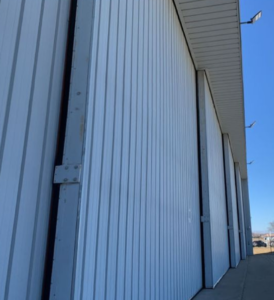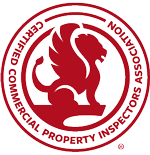The inspection of exterior doors falls under two different sections of the ComSOP: 6.5.2 Exterior and 6.5.11 Doors, Windows, and Interiors. When inspecting exterior doors, an inspector should look at: the main entry doors, service doors, sliding glass doors, and overhead and loading dock doors. It is important to know each of the different types of doors that could be found during a commercial property inspection.
Main Entry Doors
Depending on the type of building, the main entry door could be steel, wood, or glass. Regardless of the material, the main entry door should be at least 32-inches wide and always open outward. These inspection items are also part of section 6.5.12 Life Safety as well as an accessibility assessment. Main entry doors should also typically have automatic closures. A closure may not be required by all jurisdictions, but they help slow down the speed or action of the door and prevent finger pinching. Most closures are spring or hydraulically controlled and can be adjusted. The closure should keep the door from slamming and close the door slow enough to avoid hitting someone in the leg as they pass through the door.
If the entry door is constructed of glass, the glass should be safety glass and labeled as such. Safety glass will shatter into small pieces instead of shards, which would cause personal injury to anyone who comes in contact with the glass. Identifying or verifying the proof of safety glass is beyond the inspection scope, but it is important to look for a label indicating safety glass is present.
Service Doors
Service doors can be found throughout buildings. They are typically the exit doors located in the rear and on the sides of the building for employees; customers seldomly use them. In those buildings with one front and rear door, these doors are the secondary exit. Like entry doors, service doors need to open outward or in the line of travel from the interior to the exterior. These doors also typically have closures.
Sliding Glass Doors
Sliding glass doors are standards in multi-family and hospitality properties. Made largely of glass, sliding doors should also have safety glass and identification labels. These doors are also typically found to be constructed of multiple layers of glass. While identifying failed thermal pane glass is beyond the inspection scope, identifying obviously failed or fogged glass is required. When inspecting the sliding glass doors, the panels should glide easily across the tracks and have operable handles and locks.
Door Issues
In addition to meeting the ComSOP requirements, the inspector should assess the doors’ functionality and overall physical condition. This section will cover some of the items that inspectors should consider. Most exterior doors will have the same types of issues regardless of the style of the door.
While inspecting the door, verify the swing. The door should swing freely across whatever plane it is constructed against. One of the most common issues inspectors find is a door that binds against the sidewalk or entryway. If doors bind, the concrete or entry material can be milled or ground down to allow the door to swing freely.
In addition to binding along the bottom of the door, a door can also bind on the top and side jams. Inspectors should identify if this binding impedes the door’s operation or safe movement of the door. Binding could also signify structural movement, but it is primarily only isolated damage to the door and frame.
All doors should also have some means of being secured. Since these doors need to open outward, hardware is not required on the door in the building’s exterior, but interior handles and locks should be present. For example, a steel door might have a flat plate on the exterior and a handle on the interior.
Assessing the physical condition of doors typically involves looking for rust, deterioration, and other material or weather damage. This type of damage is most often found on the bottom third of the doors. At first glance, an inspector might believe the damage to be caused by poor coating and weather damage. This could be true, but this damage is often caused by poor weather-stripping. When warm air from the interior of the building is allowed to escape under or aside of a poorly sealed door, the condensation created causes the doors to rust prematurely and fail. This failure can be topical and only damage the surface or, if advanced, can cause structural damage to the jam and door.
Safety Considerations
For safety purposes, it’s also important for inspectors to determine whether exit doors are locked from the inside, chained, bolted, barred, latched, or otherwise rendered unusable at the time of the inspection. Additionally, inspectors must verify the presence of signs over lockable exit doors stating: “This Door Must Remain Unlocked During Business Hours” at all doors. This refers to any door along an exit that provides access to the outside, which may or may not necessarily be an exterior door.
Overhead and Loading Dock Doors
The most common overhead or loading dock doors are sectional-type doors. These doors are constructed by stacking several full-width sections or panels of doors to a height necessary to fully seal or enclose the door opening. This type of door could range from a small door a few feet wide and high to a door large enough to allow a large commercial truck to pass through. Section doors will have springs installed to help support and open the doors.
Another type of overhead or loading dock door is a roller-type door. These doors are made of a steel corrugated material rolled around a spindle and open and close like a window shade. These doors are typically found on single-story and narrow openings, as the weight of these doors prohibit their use in very large applications.

Overhead Sectional Door
Another type of overhead door found in commercial applications is the bi-fold or hydraulic panel door. These doors are very wide and high, and are most commonly used on airplane hangars. These doors almost always have automatic or hydraulic openers as they are very heavy to lift and require a special design.
Overhead and loading dock doors can also be sliding doors. These would best be described as barn-type doors. They are heavy doors that are mounted on upper and sometimes lower tracks. The rollers mounted on the doors glide across the tracks and open and close horizontally. This type of sliding door can also be found on airplane hangars as well.

Sliding Door – Airplane Hanger
In most cases, all these doors require mechanical assistance to open and close. This is often accomplished using springs. The sectional door and roller doors will have torsion springs and the hydraulic and bi-fold doors might have tension springs. The sliding doors will usually be found without springs. Safety cables are required when tension cables are used. This cable is found fed through the middle or interior of the spring and connected to both terminal ends. The cable will prevent a failed spring from flopping uncontrollably.
The ComSOP requires the operation of automatic openers. Unlike residential installations, not all commercial installations will include safety eyes or the same safety measures. The inspection should include the operation of the system as well as the identification of any operational issues. This would include: failure, unsafe conditions, loose electrical components, and missing elements.
Conclusion
While performing the commercial property inspection, there could be many opportunities to operate exterior doors. Each door could be a safety concern, means of egress, or something in need of replacement or repair. It is important not to overlook any of them as each door is important to your client’s repair and maintenance consideration. Door-related defects are noteworthy so your client can ask for repair allowances during their due diligence contingency period.
To learn about assessing the accessibility of entrances and doors, take CCPIA’s Accessibility Inspection for Existing Commercial Buildings Course. Some of the features include door hardware, opening forces, closing duration, thresholds, and wheelchair clearances to accommodate disabled customers and employees.
Article Written By: Rob Claus, CMI®
Additional Resources for Commercial Property Inspectors:


